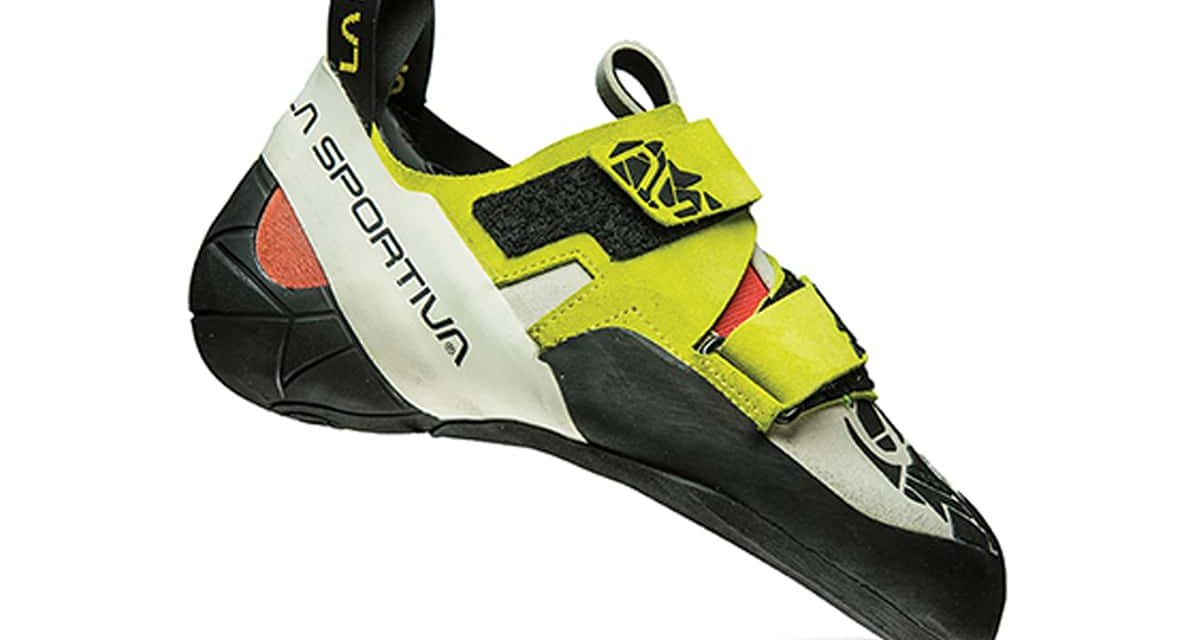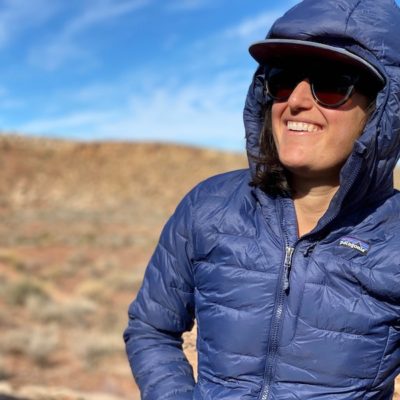The first pitches I climbed in the La Sportiva Women’s Otaki, touted by the company as a high-performance all-around shoe, were at a gently overhanging crag of chossy limestone at American Fork Canyon. The routes were old-school and techy, with a mixture of polished nubbins and pockets. It was the type of place where one might be tempted to throw an 1980’s-inspired rose move, or wobbler, just for the hell of it.
On my third pitch of the day, I found myself stupidly pumped and 12 feet above my last clip, trying to high-step onto a doubtfully small edge. Even with the 30-foot whipper that followed, I didn’t wobble, nor did I cast blame upon my new shoes. I just smiled. It was clear that the Women’s Otaki might be the best edging shoe I’ve ever worn.
Downturned Edging Power
The Women’s Otaki is an update to the much-loved and long-running Women’s Katana. They both share a moderately asymmetrical shape, and two velcro straps for closure, but the Otaki is more aggressively downturned that the Katana. It relies on La Sportiva’s acclaimed P3® platform to maintain its shape—not just from pitch to pitch, but over the course of the life of the shoe.
The more I climbed in the Women’s Otaki, the more I found its added downturn to be crucial on overhanging routes, lending the Otaki higher performance on a wider range of routes than its predecessor, the Katana. More precision, more power and more fun.
The Women’s Otaki is built on the women’s specific, WPD 75 last, which is also used in the Women’s Solution and Women’s Miura (VS and lace-up).
All-Around High Performance
At first, I was confused by the idea that a shoe could be both all-around and high performing, as the Women’s Otaki is touted by the company. It’s like saying a Porche is both powerful and fast, and is also great at moving couches.
However, I soon came to realize how accurate this description is as I brought the Women’s Otaki to a variety of different types of rock, and climbed at different angles. Whether I was pumping out limestone sport pitches, or dicing my way up sandstone slabs, or heel- and toe-hooking sandy boulder problems at Joe’s Valley, I was impressed with the shoe’s edging power. Small dishes, smears, pockets, and nubbins were no problem.

The Otakis hold an impressively solid heel hook. They are equipped with the new S-Heel™ that incorporates a mix of hard and soft rubber in a strategic design to to reduce twisting and slipping. The heel cup felt as secure as the Women’s Solution’s, but with less biting around my achilles, and a noticeable increase in lateral stiffness when weighted. It felt like I was getting more heel, with less pain.
The attributes that make the Women’s Otaki amazing on tiny footholds also reduced sensitivity a tiny bit. With 4mm of Vibram XSGrip2 rubber and a 1.1mm LaspoFlex midsole, they are slightly stiffer than the Women’s Solution. But, on vertical to gently overhanging rock I was happy to trade sensitivity for better edging, so my feet didn’t have to work so hard. These shoes strike a very nice balance between support and sensation and I’ve been loving them on everything except for the steepest problems and routes.
Also, the 4mm edge will ensure that the shoe lasts longer than some of the thinner, more sensitive high-performance shoes on the market these days.
Sizing
I’m a long-time La Sportiva fan, so the Otaki felt familiar on my foot, and fit snugly with no gaps. I tested a size 36.5, the same size I wear in Women’s Miura VS and Solutions as well as Testarossas. My street shoe size is a US women’s 8 and I wear my climbing shoes just tight enough that breaking them in means wincing from pain for the first few days of climbing.
They also sport a snazzy but not-too-girly, watermelon color palette, which I appreciate because I’m a sucker for pretty things.
Bottom Line
In a time when climbing shoes are trending towards specialization and specific use cases, the Otakis stand out as a legitimate high-end all-around option. It sure does simplify life to be able to rely on one pair of shoes pretty much everywhere I go. I’m even feeling inspired to let go of some of my 15-plus pairs of half worn-out shoes.
At $175 the Otaki’s are comparable in price to similar well-built top shelf shoes. They also sport a snazzy but not-too-girly, watermelon color palette, which I appreciate because I’m a sucker for pretty things.
For really steep stuff (40-degrees overhanging or more), I do prefer a softer shoe than the Otakis, and, obviously, I’d never stick my Otakis in a crack, but if I had to choose just one shoe or 75% of climbing situations, the Women’s Otaki would be the one. I’d recommend the Women’s Otaki for any ladies looking for one go-to shoe that can get the job done for most sport climbing and bouldering, and for anyone looking for a shoe that slays on the tiniest of footholds.




Recent Comments